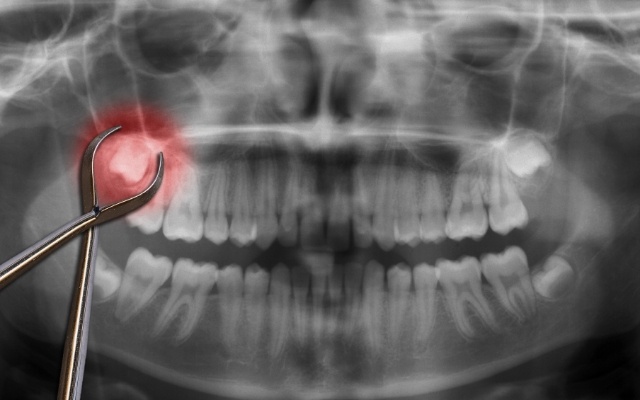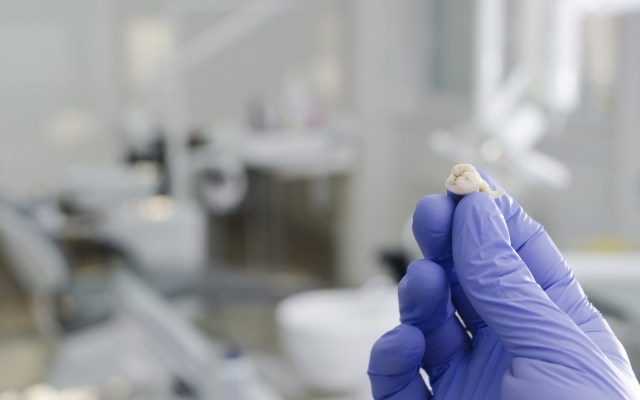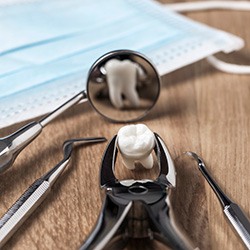Tooth Extractions – Chaska, MN
Do What’s Best for Your Smile
Your natural smile is irreplaceable. Even as amazingly lifelike as modern dental restorations have become, nothing beats what your natural teeth are capable of. That is why our dentistry team at Chaska Dental Center works so hard to ensure your smile’s longevity through effective, conservative restorative and emergency dentistry treatments. However, if the need ever arises, our experienced dental team can also extract a tooth in order to save the rest of them. Have you put off getting a tooth extracted? Contact us to schedule your consultation today to discuss tooth extractions in Chaska, MN!
Why Choose Chaska Dental Center for Tooth Extractions?
- Local Anesthetic Given Painlessly via The Wand™
- Nitrous Oxide to Reduce Pain & Anxiety
- Experienced Dentists Who Prioritize Your Comfort
What Is a Tooth Extraction?

Although your tooth enamel is the strongest material in your body, your teeth are actually held in place by the gum tissue and support from your jawbone. The top portion of the tooth, called the crown, can encounter minor decay or damage and require a prosthetic crown without having to disturb the roots underneath. A tooth extraction occurs when the entire tooth, including the root structure, is removed from the socket.
Why Do I Need to Have a Tooth Extracted?

In general, when given the choice between preserving a tooth or removing it, we prefer saving the natural tooth. But sometimes, extracting the tooth truly is necessary, such as in the following situations:
- The patient has severe gum disease.
- Injury or decay has left inadequate tooth structure to support a dental crown.
- A primary (i.e., baby) tooth is preventing a permanent tooth from erupting properly.
- Wisdom teeth are impacted.
- Extra room is required to fit a new denture or orthodontic treatment.
How Is a Tooth Extracted?

Believe it or not, there is more than one way to extract a tooth. In some situations, we can simply pull the tooth out of its socket without too much effort. In others, we need to break the tooth into smaller pieces and extract it in sections. The method we use to remove a tooth depends on many factors, including the location of the tooth in the mouth and the reason for extraction.
Does a Tooth Extraction Hurt?

At Chaska Dental Center, Dr. Swingdorf, along with the rest of the team, go to great lengths to ensure patient comfort throughout the entire process. You shouldn’t feel anything during the procedure itself, but if needed, we can use nitrous oxide to help you feel more relaxed. As you heal, following our aftercare instructions can reduce any discomfort and prevent complications.
Understanding the Cost of Tooth Extractions

The cost of tooth extractions requires that you undergo an initial consultation with one of our dentists at Chaska Dental Center. As an invasive procedure, it often involves our team evaluating the state of your smile as well as what kind of removal method must be used. Combining these factors along with others, we can deliver a more complete estimate that we will discuss with you. Keep reading to discover how our team can help when it comes to understanding the price of treatment.
Factors That Can Affect Tooth Extraction Cost

Dr. Swingdorf will create a personalized treatment plan and cost estimate for you to review. Part of this process involves considering various factors that ultimately determine how much you can expect to pay to have one or more teeth removed. These factors include:
- The Number of Teeth That Need to Be Removed: Removing a single tooth will naturally cost less than having multiples extracted; however, our dentists may find that it will be more beneficial and cost-effective in the long run to remove several problematic teeth at once.
- The Location of Each Tooth: Teeth located toward the back of the mouth (molars) are harder to reach and can require more complex surgery – a factor that can increase the price of treatment.
- The Type of Extraction Required: A simple procedure is likely to cost less than a surgical one because the latter requires a more invasive approach.
- Whether Sedation is Necessary: Local anesthesia is commonly used to prevent pain throughout a procedure; however, if sedation is necessary, this will increase the overall cost.
Does Dental Insurance Cover Tooth Extractions?

Sometimes, tooth extraction is the best or even the only treatment option available. As a result, it can be deemed a necessary dental service and will often be partially covered by dental insurance (50-80%). However, before starting the procedure, it is important to confirm your benefits so that you know exactly what you’ll be responsible for paying at the time of service.
Other Options for Making Tooth Extractions Affordable

If you do not have a private dental insurance plan that you can use to lower your out-of-pocket costs, you can pay for your tooth extraction in other ways. At Chaska Dental Center team welcomes Visa, Mastercard, American Express, and Discover credit card payments, and we are pleased to provide a 5% savings for available treatments (some restrictions do apply).
Tooth Extraction FAQs
Does a Tooth Extraction Hurt?
At Chaska Dental Center, Dr. Swingdorf, along with the rest of the team, go to great lengths to ensure patient comfort throughout the entire process. You shouldn’t feel anything during the procedure itself, but if needed, we can use nitrous oxide to help you feel more relaxed. As you heal, following our aftercare instructions can reduce any discomfort and prevent complications.
What’s the difference between tooth extractions and wisdom tooth surgery?
While both involve removing a tooth, tooth extractions and wisdom tooth surgery are different procedures. Primarily, wisdom tooth removal focuses solely on the third molars (the final set). Regular tooth extractions can be performed on any tooth that has suffered irreversible damage or is causing overcrowding.
Another difference between these two procedures is that wisdom tooth removal often requires surgery. This most commonly occurs when a wisdom tooth is impacted beneath the gumline and cannot be extracted any other way.
Can I leave the space empty after a tooth extraction?
Unless it is a wisdom tooth, you should never leave the space empty after a tooth extraction. Many patients assume that if the tooth being removed is toward the back of the mouth it does not need to be replaced; however, this is not true.
Empty sockets that have no tooth root to stimulate the jawbone can lead to further tooth and bone loss over time. Also, missing teeth can hinder your ability to chew and speak clearly. This can result in poor nutrition and indigestion as well as slurred speech.
Once you have a tooth extracted, you’ll need to meet with your dentist to discuss your options for proper replacement so that your smile and daily oral function do not suffer in the long term.
How should I prepare for my tooth extraction?
Preparation for your tooth extraction is just as important as following the aftercare instructions that you’ll receive from our Chaska Dental Center team. Before the day of your procedure, it’s important that you ask your dentist any questions that you might have as well as what you can eat beforehand and what you should bring.
We will make sure that you know what you should do the morning of your procedure, such as drinking just water or making sure to pick up any prescription medication before you arrive. You’ll also want to make sure that you have someone who can take you home after your procedure, as the local anesthesia (or general anesthesia) will take time to wear off, and it will not be safe for you to drive yourself.









